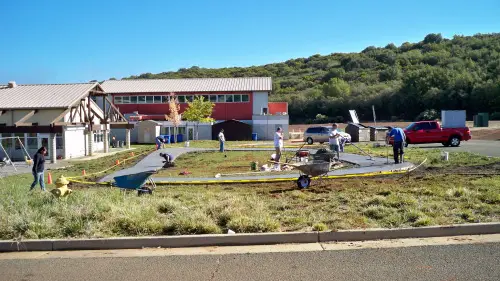- Lake County News Reports
- Posted On
Report estimates startling decline for salmon, other native fish
The report, “SOS: California's Native Fish Crisis,” was written by Dr. Peter Moyle of the University of California, Davis – a renowned expert on California’s water systems and the fish that inhabit them – and released by California Trout Nov. 18.
It's the first-ever comprehensive report chronicling the status of each of California’s native fish species – salmon, steelhead and trout.
Moyle's findings are startling. He estimates that 65 percent of native salmon, steelhead and trout species may be extinct within 100 years.
He writes that the state’s native salmonids are in unprecedented decline and are teetering towards the brink of extinction – an alarm bell that signals the deteriorating health of the state’s rivers and streams that provide drinking water to millions of Californians.
“The fish don’t lie,” said Moyle. “The story they tell is that California’s environment is unraveling. Their demise is symptomatic of a much larger water crisis that, unless addressed, will severely impact every Californian.”
Sen. Patricia Wiggins (D-Santa Rosa), chair of the California Legislature’s Joint Committee on Fisheries and Aquaculture, said that Moyle's findings “mean that unless we make immediate, real changes to protect the environmental health of our rivers, streams and oceans, wild salmon as we know it will disappear from our dinner plates.”
“It wasn’t too long ago that salmon flourished throughout Northern and Central California. In just one generation we have lost significant salmon and steelhead runs in the Russian, the Eel and the Klamath rivers, as well as rivers in the Central Valley,” said Wiggins. “Our entire salmon fishing season was shut down last year. This is creating economic disasters for fishermen and the sport-fishing industry. Emergency relief funding will only last so long, and we cannot afford for fishing communities to lose their way of life.”
Moyle's report cites a number of key stressors on California’s native fish populations, many of which could be addressed through improved policy planning and better water and land management. Dams, agricultural and grazing practices, development, mining, railroads, logging, some recreational uses, illegal harvesting of native fish, reliance on fish hatcheries, and invasive species have all played a role in driving these species to the brink of extinction.
Global warming has perhaps played the most significant role in the alarming drop in numbers for many of these fish, as salmonids are particularly sensitive to changes in water temperature and rapidly shifting ocean conditions affect those that migrate between rivers and the ocean.
Thirty-two native fish taxa – species, subspecies, Evolutionary Significant Units, and Distinct Population Segments – are evaluated in the report. Each type of fish was evaluated according to the same criteria and given a score that indicates its likelihood of long-term survival under current conditions. A score of “one” indicates the species is “highly vulnerable to extinction in native range in the next 50 years” and a score of “four” or “five” was reserved for species with no extinction risk and expanding populations.
Of the 32 taxa analyzed in the report, one is extinct in California and an additional fourteen are listed as state and/or federally threatened or endangered. Pink and chum salmon, southern steelhead, and coho salmon face the greatest immediate threat of extinction.
Other species racing against the clock for survival include both summer and winter runs of the Northern California Coast steelhead; Central Valley, South/Central California Coast and Central Coast steelhead; Little Kern golden, Lahontan cutthroat, and Paiute cutthroat trout; and California Coast, Sacramento winter run, and Central Valley spring run Chinook salmon.
The report finds that identifying new and innovative funding streams for the state Department of Fish and Game (DFG) would allow the department to be a more effective steward of the state’s fishery resources. It also argues vigorously for a revitalized and strengthened DFG that would enable it to fulfill its role as chief guardian of California’s wild and native salmon, steelhead, and trout by partnering with local communities to protect regional fish populations and their habitats.
And it calls for immediate action on salmon, steelhead and trout recovery needs, such as addressing known challenges on the Shasta River and Trinity Rivers and continuing efforts to protect ground and surface water resources at the local and state levels.
Ongoing research and restoration efforts have shown that when flows are reinstated, migration barriers removed, and cool, clean, abundant water provided, our native fish show signs of recovery.
“This report is an important resource for anyone interested in protecting and restoring California’s magnificent native fish,” said CalTrout Executive Director Brian Stranko. “From local watershed groups working in communities, to the highest levels of state and federal governments, SOS: California’s Native Fish in Crisis provides the information, the roadmap, and the guidance for affecting change for California’s fish and the habitat that supports them.”
Last year, Gov. Arnold Schwarzenegger signed Wiggins' bill, SB 562, which supports salmon monitoring and restoration with nearly $5.3 million in funding. Wiggins said the money may enable California to secure up to $20 million in federal matching funds, which will go to basic science and the repair of specific problems on creeks and rivers.
While it's an important investment, Wiggins said more is needed.
“In January I will bring to the Legislature a package of bills to save our salmon,” she said. “I will need cooperation from fishermen, farmers, water users, the tribes, power companies, the governor’s office and my colleagues in the Legislature to pass these measures.”
She added, “California Trout calls the findings an ‘alarm bell that signals the deteriorating health of the state’s rivers and streams that provide drinking water to millions of Californians.’ They stress that water unfit for fish is a sign of water unfit for people. No less than a full recovery is necessary for our fishing and sport-fishing economy, for our responsibility to the species, and for great-tasting, healthy wild salmon – a continuing California tradition.”
{mos_sb_discuss:2}










